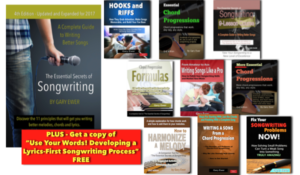Whenever you play a chord, you’re usually playing it in what’s called root position. This means that the root of the chord (the note represented by its letter name) is going to be the lowest-sounding note — the one that the bass is playing.
 If you want hundreds of chords to experiment with, “The Essential Secrets of Songwriting 10-eBook Bundle” includes two collections of chord progressions, along with “How to Harmonize a Melody.” Get your chords working properly!
If you want hundreds of chords to experiment with, “The Essential Secrets of Songwriting 10-eBook Bundle” includes two collections of chord progressions, along with “How to Harmonize a Melody.” Get your chords working properly!
So if you see ‘C’ in the chord chart, you play a chord that uses the notes C, E and G in whatever configuration or voicing you like, just so long as the note ‘C’ is the lowest sounding one.
You may be aware, however, that it’s quite possible to put a different note from that chord at the bottom. For example, you might decide to have the bass player in your band play an E while that C chord is happening. When written out, the chord would look like this:
C/E
Whenever you see a slash in a chord, the note to the left of the slash (C) is the actual chord you should be playing, and the note to the right of the slash (E) is the note that should be the lowest-sounding one, the one the bassist should be playing.
That chord, C, is technically called a triad, because it uses three different notes. With triads you have 3 possibilities for what you might use as your lowest note:
- The root of the chord (which is what we normally play), and we call that chord a root position chord, or root position triad.
- The 3rd (the middle note of C-E-G) of the chord, and we call that chord a first inversion chord or first inversion triad.
- The 5th (the top note of C-E-G) of the chord, and call that chord a second inversion chord or second inversion triad.
You’ll notice something interesting, and musically valuable when you play chords in various positions: the root position chord gives us a chord that’s considered to be musically stable. The first inversion chord sounds a bit less stable, and the 2nd inversion chord gives us one that’s the least stable of all of them.
When we use those terms “stable”, “less stable” or “least stable”, you need to know that these are not synonymous with “desirable”, “less desirable” or “least desirable.” Inversions have a particular use, and chords that are less stable are great to use in progression because their instability can provide a lot of forward motion.
Here’s what I mean. Let’s say you’ve got this progression, where you strum each chord for 4 beats:
C F G7 C
Those are all root position chords. For each chord we should hear the letter name of the chord as the lowest-sounding note.
Now let’s insert a chord: C/E. We’ll put that in between the C and the F chord. Strum C for 2 beats, C/E for 2 beats, and then G7 and the final C for 4 beats:
C C/E F G7 C
So as you can hear, “instability” simply means that there’s an innate characteristic in that C/E chord… the desire to move forward to the next chord, and you can hear it quite easily.
If you play C/G instead of C/E, you’ll notice that there’s a different effect:
C C/G F G7 C
As a songwriter, you simply need to decide what version of the chord you like, and then use it.
Other Reasons to Use Inversions
Other than creating a sense of forward motion, there are other reasons you might use a chord inversion:
- To create a more interesting bass line.
- To create a general sense of chord variety.
- To smooth out a jumpy bass line.
In that regard, the best way to decide if your progression might benefit by inserting a chord inversion is to look at the bass line that gets created by the inversion. Chord inversions will sound awkward if the bass line sounds awkward or forced.
And one other bit of advice: Chord progressions do not need to include inverted chords. They can be an interesting addition to any progression, but they aren’t necessary for a progression to do its job.
 Written by Gary Ewer. Follow Gary on Twitter.
Written by Gary Ewer. Follow Gary on Twitter.
 “The Essential Secrets of Songwriting” 10-eBook bundle comes with a Study Guide. That guide shows you the best way through all the materials, and help you discover all the secrets to great songwriting. The Bundle includes a free copy of “Use Your Words! Developing a Lyrics-First Songwriting Process”
“The Essential Secrets of Songwriting” 10-eBook bundle comes with a Study Guide. That guide shows you the best way through all the materials, and help you discover all the secrets to great songwriting. The Bundle includes a free copy of “Use Your Words! Developing a Lyrics-First Songwriting Process”










